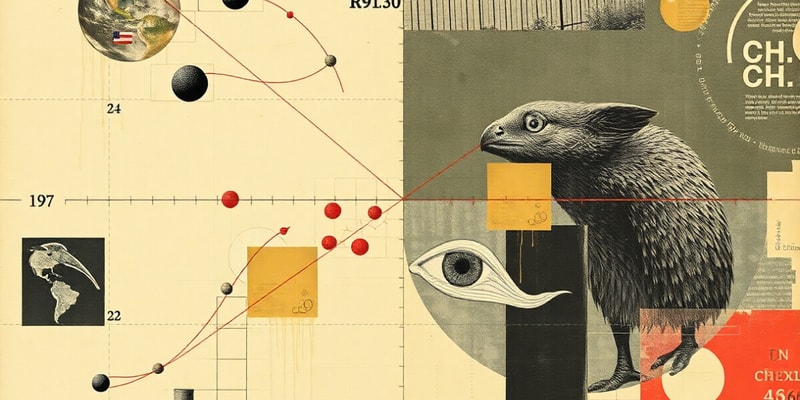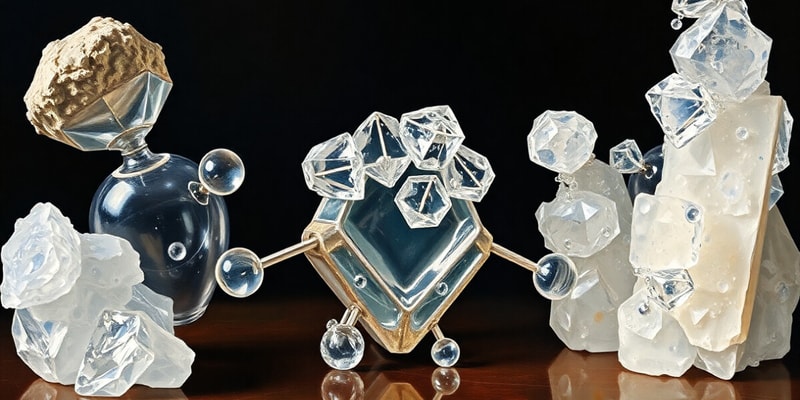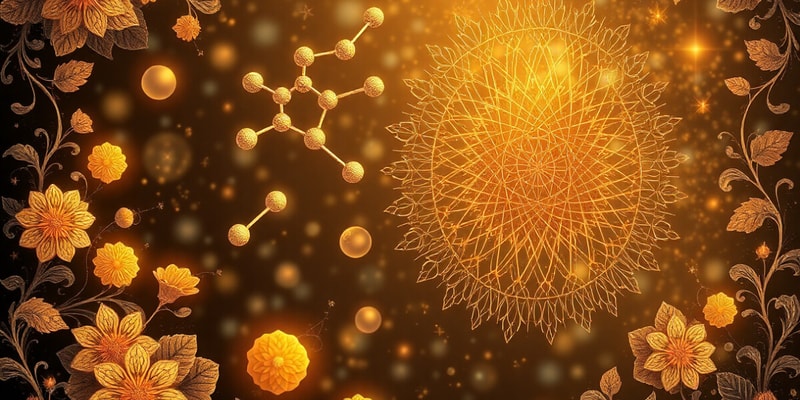Podcast
Questions and Answers
What is the relationship between activity and concentration in real systems?
What is the relationship between activity and concentration in real systems?
Activity (ai) is directly proportional to concentration ([i]) and is expressed as ai = γi[i], where γi is the activity coefficient.
Why are activities preferred over concentrations in expressions for equilibrium constants?
Why are activities preferred over concentrations in expressions for equilibrium constants?
Activities provide a more accurate representation of the state of a system under real conditions, as they account for non-ideal interactions among particles.
Express the equation for the chemical potential of component i in a real system.
Express the equation for the chemical potential of component i in a real system.
The equation is μi = μi° + RT ln ai, where ai is the activity of component i.
In the context of free energy changes, what does the equation ∆G = ∆G° + RT ln K represent?
In the context of free energy changes, what does the equation ∆G = ∆G° + RT ln K represent?
Signup and view all the answers
What does the term 'activity coefficient' signify in thermodynamics?
What does the term 'activity coefficient' signify in thermodynamics?
Signup and view all the answers
How is the equilibrium constant K expressed in terms of activities?
How is the equilibrium constant K expressed in terms of activities?
Signup and view all the answers
What is the significance of standard free energy (∆G°) in the context of chemical reactions?
What is the significance of standard free energy (∆G°) in the context of chemical reactions?
Signup and view all the answers
What is meant by the term 'ideal gas' in relation to free energy changes?
What is meant by the term 'ideal gas' in relation to free energy changes?
Signup and view all the answers
Describe the role of the natural logarithm in the equation for chemical potential.
Describe the role of the natural logarithm in the equation for chemical potential.
Signup and view all the answers
Why can concentrations sometimes be used as an approximation in equilibrium expressions?
Why can concentrations sometimes be used as an approximation in equilibrium expressions?
Signup and view all the answers
What is crystal polymorphism and why is it significant in pharmaceuticals?
What is crystal polymorphism and why is it significant in pharmaceuticals?
Signup and view all the answers
How does temperature affect the stability of crystal polymorphs in pharmaceuticals?
How does temperature affect the stability of crystal polymorphs in pharmaceuticals?
Signup and view all the answers
In a phase diagram with two solid regions, what do the regions S1 and S2 represent?
In a phase diagram with two solid regions, what do the regions S1 and S2 represent?
Signup and view all the answers
What is the significance of chemical potential in a real system with multiple components?
What is the significance of chemical potential in a real system with multiple components?
Signup and view all the answers
Explain the difference between total free energy in ideal and real systems.
Explain the difference between total free energy in ideal and real systems.
Signup and view all the answers
Given the equation $G_{T,P} = \mu_A n_A + \mu_B n_B + \mu_C n_C$, what does each symbol represent?
Given the equation $G_{T,P} = \mu_A n_A + \mu_B n_B + \mu_C n_C$, what does each symbol represent?
Signup and view all the answers
What is the relation between free energy change ($\Delta G$) and equilibrium constant ($K_{eq}$)?
What is the relation between free energy change ($\Delta G$) and equilibrium constant ($K_{eq}$)?
Signup and view all the answers
What happens to the free energy of a gas system when it is not at equilibrium?
What happens to the free energy of a gas system when it is not at equilibrium?
Signup and view all the answers
Why is it important to control the crystal form of drug products?
Why is it important to control the crystal form of drug products?
Signup and view all the answers
In terms of non-ideality, how do solubility and stability relate to the free energy of a system?
In terms of non-ideality, how do solubility and stability relate to the free energy of a system?
Signup and view all the answers
Study Notes
Polymorphism
- Pharmaceutical compounds can exist in multiple crystalline solid forms.
- These different forms are called polymorphs.
- Example: Paracetamol has at least three polymorphs.
- Stability can vary with temperature.
- Pharmaceutical compounds can also exist in amorphous (non-crystalline) solid forms.
- The crystal form of a drug product affects properties like solubility.
Phase diagrams
- Phase diagrams can be used to describe the conditions (temperature and pressure) under which different polymorphs are stable.
- These diagrams are similar to basic one-component phase diagrams but with multiple solid regions.
- Each solid region corresponds to a different polymorph.
Non-ideality
- The equations for free energy, enthalpy, entropy and internal energy are defined with reference to ideal gas systems.
- Real systems, such as solids and liquids, deviate from ideality.
- To account for non-ideality, we need to consider the interactions between components.
Chemical potential
- Chemical potential (µ) is a concept used to describe the contribution of each component to the overall free energy of a real system.
- It accounts for the mutual interactions between components.
Total free energy
- For a real system with three components (A, B, and C) with nA, nB, and nC moles of each, the total free energy at a specific temperature and pressure (GT,P) is:
- GT,P = µA nA + µB nB + µC nC
Free energy changes in real systems
- For an ideal gas, the free energy change is:
- ∆G = ∆G° + RTln(P/P°)
- This equation is similar to the equilibrium constant equation:
- ∆G° = -RTlnKeq.
- For real systems, the free energy change equation takes into account the activity of each component:
- µi = µi° + RTln(ai)
- ai is the activity of component i.
Activity and Activity coefficient
- Activity is a measure of the effective concentration of a component in a real system, taking into account interactions with other components.
- It is directly proportional to concentration.
- The proportionality constant is called the activity coefficient (γ).
- ai = γi[i]
Free energy changes in real systems (continued)
- For a process involving multiple components, the free energy change is:
- ∆𝐺 = ∆𝐺 ° + 𝑅𝑇 ln 𝐾
- The equilibrium constant (K) is given by:
- K = (aC)^c (aD)^d / (aA)^a (aB)^b
- In some cases, activities can be approximated with concentrations.
Studying That Suits You
Use AI to generate personalized quizzes and flashcards to suit your learning preferences.
Related Documents
Description
Explore the concepts of polymorphism in pharmaceutical compounds, including the significance of different crystalline forms and their stability. Learn about phase diagrams and how they illustrate the conditions under which various polymorphs are stable. Understand the implications of non-ideality in real systems compared to ideal gas models.




